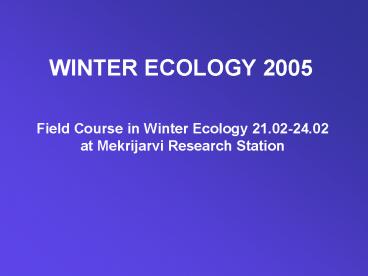WINTER ECOLOGY 2005 - PowerPoint PPT Presentation
1 / 21
Title:
WINTER ECOLOGY 2005
Description:
The lakes are situated close to each other near Ilomantsi ... or methods used: Ruttner sampler, Kajak sampler, Secci disc and Winkler method ... – PowerPoint PPT presentation
Number of Views:74
Avg rating:3.0/5.0
Title: WINTER ECOLOGY 2005
1
WINTER ECOLOGY 2005
- Field Course in Winter Ecology 21.02-24.02 at
Mekrijarvi Research Station
2
Lake Ecosystem in Winter
- Instructor Matti Leppanen
- Group Anna Arnkil
- Elisabeth Heigl
- Eva Pier
- Magdalena Madalinska
- Tarja Kainlauri
- Stefan Gerdes
- Tom Nagawiecki
- Jordi Canals
3
The goal
- Proper water sampling
- Analize physical, chemical and biological
parameters of lakes - Compare both lakes over time
4
Terrain of studies
- The terrain of studies comprised Iso-Suokko and
Mekrijarvi Lakes - The lakes are situated close to each other near
Ilomantsi - The lakes studied were different in depth and size
5
Characteristic
- Iso-Suokko Lake
- The lake has small surface area-26 ha and 7m
depth(max.depth 15m) - Mekrijarvi Lake
- The lake has big surface area-894 ha and 1.7m
depth(max.depth 3m)
6
Physical chemical measurements
- DO (mg/L)
- pH
- Conductivity
- Colour
- Water temperature
- Water depth
- Secci
- Ice thickness
- Snow thickness
Mentionable material or methods used Ruttner
sampler, Kajak sampler, Secci disc and Winkler
method
7
Physical and chemical measurements- Iso-Suokko -
22.02.2005 24.02.2005 Mean Surface
Bottom Surface Bottom
Surface Bottom
8
Physical and chemical measurements- Mekrijärvi -
21.02.2005 23.02.2005 Mean
9
Physical chemical measurements - Results
- both Lakes are cloudy (mean secci-depth is 0.34 m
(IS)/0.37 m (M)) - both Lakes are acidic (pH about 5.5)
- both Lakes have a low ion concentration (gt soft)
- Iso-Suokko Lake is significant deeper than Lake
Mekrijärvi (about 10 m / 2 m) - both water bodies show humic features (typical
for Finnish lakes)
10
Physical chemical measurements - Results
- bottom oxygen-saturation-difference in comparison
to 2003 in Iso-Suokko Lake - longer fall in 2004 might be the explanation by
longer influence of wind mixture
11
Physical chemical measurements - Results
12
Zoobenthos
animal life associated with substrate
of water bodies
Oligochaeta
Chaoboridae
Chironomidae
13
Zoobenthos
- more taxa and higher number of individuals in
Lake Mekrijärvi - (most common Chironomidae (M IS) and
Chaoboridae (IS) - BUT Shannon-Weaver index analysis implies higher
biodiversity at Lake Iso-Suokko - Mekrijärvi 1.03 with maximum of 2.40
- Iso-Suokko 1.02 with maximum of 1,61
- (the higher the difference the less biodiv.)
14
Zoobenthos summer/winter
- little number of samples and difference in years
those were taken lower comparison reliability - table indicates higher biodiversity in summertime
- some families present in both seasons (e.g.
Chironomidae, Chaoboridae) while others (e.g.
Oligochaeta) were absent or rare in winter
15
Zooplancton
- most abundant taxa in
- Mekrijärvi Rotifera
- Iso-Suokko Copipoda
- according Lake Iso-Suokko there are more
organisms at the surface compared to the bottom - similar numbers in amount of individuals let
doubt about data collection process (reliability)
if difference in characteristica of both lakes is
taken into account (trophic status, depth... )
16
Zooplancton
- high deviation in Shannon-Weiner-index indicates
little biodiversity in both lakes - (dominant abundance of one/two taxa)
- same index shows more diversity for bottom
compared to surface - little data processed by many single persons has
to be considered as arguable
17
Zooplancton summer/winter
- general dogma about differences in summer/winter
zooplancton populations - higher input of sunlight -gt warmer water -gt
better conditions for photosynthesis -gt higher
population - higher numbers of Cladocera in winter can be
explained by life cycle of it (males not present
in winter and also female breeding in summer)
18
Zoobenthos - discussion
- Lake Iso-Suokko with more stable living
conditions than Mekrijärvi due to depth and thus
more stable oxygen and temperature stratification - compared to earlier years higher biodiversity
level (also because of late winter initiation?)
19
Zooplancton - discussion
- lesser abundance of Chironomidae in summer is due
to higher primary production and thus lesser
oxygen content - summer species diversity was higher in more
shallow lake Mekrijärvi resulting from higher
primary production and thus higher food supply
for invertebrate organisms
20
References
- (1) Huttunen, M. A. (ed.) 2004
Field Course in Winter Ecology 2004 University
of Joensuu, Department of Biology
http//bio.joensuu.fi/winter/w2004.doc - (2) Huttunen, M. A. (ed.)
2003 Field Course in Winter Ecology 2003
University of Joensuu, Department of Biology
http//bio.joensuu.fi/winter/w2003.doc - (3) Huttunen, M. A. (ed.)
2002 Field Course in Winter Ecology 2002
University of Joensuu, Department of Biology
http//bio.joensuu.fi/winter/w2002.doc - (4) Huttunen, M. A. (ed.)
2001 Field Course in Winter Ecology 2001
University of Joensuu, Department of Biology
http//bio.joensuu.fi/winter/w2001.doc - (5) Wetzel, R.G., 2001.
Limnology, 3rd edition, Saunders College
Publishing - (6) Baumgartner, Albert
Liebscher, Hans-Jürgen 1996 Allgemeine
Hydrologie, Quantitative Hydrologie 2nd
edition Gebrüder Borntraeger-Berlin-Stuttgart - (7) Hütter, Leonhard A.
1992 Wasser und Wasseruntersuchung 5th
edition. Frankfurt am Main Otto Saale Verlag
Verlag Sauerländer - (8) Homepage of Mekrijärvi
field station www.joensuu.fi/mekri/mekri.htm - (9) Moss, Brain Ecology
of Freshwaters 1980 Blackwell Scientific
Publications - (10) Lerman, Abraham (ed.)
Lakes Chemistry, geology, physics 1978
21
End of presentation Questions?































